Creeping Lawn Weeds: Identification and Control (With Pictures)

Creeping lawn weeds can be a nuisance because they can quickly take over your well-cared-for grassy areas in a yard. The invasive, spreading lawn weeds like crabgrass, creeping Charlie, and chickweed can ruin the appearance of lush turfgrass. Moreover, creeping lawn weeds are difficult to eradicate from grass because the roots spread almost everywhere. However, with proper identification and control methods, you can keep your lawn weed-free and healthy.
Creeping weeds cause havoc in front and backyard lawns. The unwelcome plants compete for resources like water, nutrients, and sunlight. This weakens the grass, creating uneven patches and spoiling the lawn’s aesthetics. Because of this, lawns with creeping weeds are usually unhealthy and look in bad shape.
This article is a comprehensive guide to identifying and controlling creeping lawn weeds. Descriptions and pictures of common creeping weeds, such as crabgrass, clover, and ground ivy (creeping Charlie), will help you identify these invasive plants and get rid of them for good.
What is a Creeping Weed?
A creeping lawn weed is an unwanted plant that spreads horizontally across the grass. The spreading weed uses stolons, rhizomes, or other methods to spread, creating a mat-like growth. Noxious weeds infiltrate lawns, disrupting the turfgrass’s uniform growth and appearance. Additionally, creeping lawn weeds are difficult to manage and eliminate to maintain a healthy and attractive lawn.
Common Creeping Lawn Weeds
Two of the most common lawn weeds that spread along the ground are creeping Charlie—also called ground ivy—and creeping Jenny. These unwanted creeping weeds spread horizontally, creating dense mats that choke grass growth and spoil the lawn’s appearance. Vigilant management is essential to preserve the lawn’s health and aesthetics.
How to Prevent Creeping Lawn Weeds
Preventing creeping lawn weeds involves a multi-tasked approach. A combination of regular maintenance and keeping a lawn healthy will hinder weed invasion. Also, good lawn care methods like regular mowing at the recommended height, providing nutrients, removing excess thatch, and aeration are good ways to prevent creeping lawn weeds.
Additionally, watering a lawn deeply and infrequently encourages deep root growth in the grass. This makes turfgrass more resilient against weed competition. Also, overseeding bare spots and thin areas with quality grass seed helps fill in gaps, giving fewer opportunities for weeds to get established.
Related reading: Organic lawn care tips.
How to Control Creeping Lawn Weeds
Getting rid of creeping lawn weeds is tricky because they tend to have extensive root systems. Therefore, it can be challenging to remove the entire weed so that it never returns.
The best way to control lawn weeds with a creeping habit is to mow the lawn regularly. The ideal mowing height for warm-season grasses is 2” to 2.5” (5 to 6 cm) tall. Cool-season grasses thrive when mowed at 3” to 4” (7.5 – 10 cm) high. Longer grass blocks out light at the soil level, preventing weeds from taking root.
In most cases, the best way to eliminate creeping lawn weeds is to remove them by hand. Although time-consuming, this method effectively removes the entire weed and its roots. It also avoids using herbicides which could impact the environment.
However, in some cases, controlling creeping lawn weeds with a suitable herbicide is the only option.
Related reading: Homemade weed killers for lawns.
Creeping Lawn Weeds — Identification, Pictures, and Control
Here are common types of lawn weeds with creeping habits that can be tough to eliminate from lawns.
Crabgrass (Digitaria ischaemum)
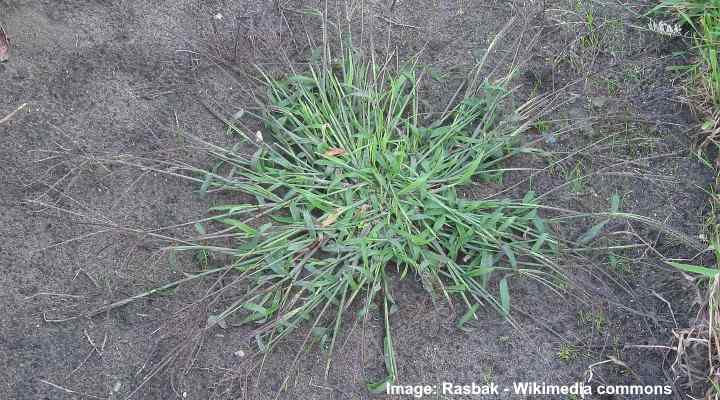
Crabgrass is a low-growing, tough, creeping weed that is hard to remove from lawns completely. It’s a weedy annual plant with aggressive growth that easily sprawls across a lawn. Creeping crabgrass can also grow in clumps, spoiling the appearance of a lush lawn. Crabgrass competes for resources and nutrients, causing stress and impacting the lawn’s health.
Crabgrass grows 3” to 6” (7.5 – 15 cm) tall and has dull, light green linear leaf blades. It spreads through seed dispersal. Therefore, eliminating it requires removing the plant before the weed seeds.
Creeping lawn weed control tips: The best way to eradicate crabgrass is by hand-pulling the weeds as soon as they appear in the season. Keeping grass over 3” (7.5 cm) tall and maintaining lawn health will help turfgrass compete successfully with this weed.
Henbit (Lamium amplexicaule)
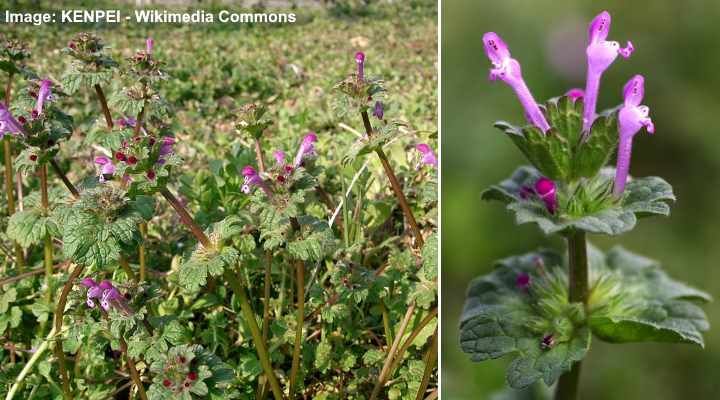
Henbit is a common annual creeping, low-growing lawn weed that emerges in early spring. This broadleaf weed spreads aggressively in turfgrass due to its seeds and tough taproots. Henbit is identified by its low-growing habit, tiny purple flowers, and heart-shaped leaves with scalloped edges. Also called deadnettle, the annual weed grows 4” to 10” (10 – 25 cm) tall.
You’ll find henbit in fields, roadsides, lawns, and flower beds. While used for ground cover on slopes to prevent erosion, it’s unwelcome in lawns due to its rapid spread.
Henbit is easy to confuse with other tough weeds in the lawn, like creeping Charlie. However, it typically sprouts in winter and dies by spring.
Creeping lawn weed control tips: Hand pulling or using a weed control product specifically designed for broadleaf weeds can also effectively eliminate the lawn weed. Also make sure to mow the lawn regularly. This helps prevent henbit’s seeds from spreading.
Creeping Jenny (Lysimachia nummularia)
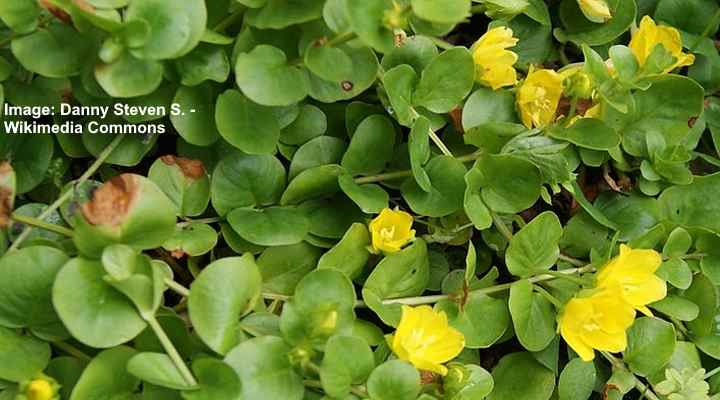
Creeping Jenny is a vigorous, ground-hugging, weedy plant that can cover lawns in yellow flowers. This tough lawn weed is characterized by its spreading stem nodes that root where the nodes touch the soil. It’s a pesky weed because it can spread quickly and create a carpet-like ground cover.
In some regions, creeping Jenny is a yellow-flowering ground cover plant with several beneficial landscape uses. However, the non-native prostrate perennial plant spreads aggressively in North America and can choke out native lawn grasses. Therefore, if you choose to use the plant for ground cover, avoid planting it near lawns as it’s difficult to control.
Creeping lawn weed control tips: To remove creeping Jenny from lawns, allow the grass to grow longer to starve the unwanted plants of light. Also, manually removing the plants early in the season can help prevent their spread.
Creeping Charlie (Glechoma hederacea)
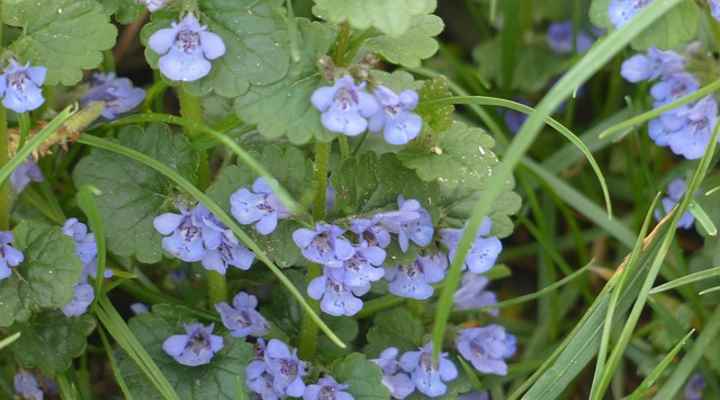
Creeping Charlie is a creeping lawn weed that is tough to get rid of. Its ability to take over lawns quickly comes from its underground rhizomes, making control difficult. Creeping Charlie is identified by its small purple flowers, heart-shaped leaves with scalloped edges, and velvety texture. The leaves grow in clusters along creeping stems that root at nodes.
The issue with purple-flowering creeping Charlie is that it forms thick mats in lawns. Its aggressive growth outcompetes grass for essential resources like sunlight, water, and nutrients. Additionally, it thrives in shaded areas where grass tends to struggle to grow. Because it’s a low-growing weed, it’s resistant to mowing.
Creeping lawn weed control tips: Like most natural lawn weed control methods, hand-pulling the weed can be effective. It’s also a good idea to ensure no bare spots are on your lawn, as creeping Charlie can easily establish itself in those places.
Purslane (Portulaca oleracea)
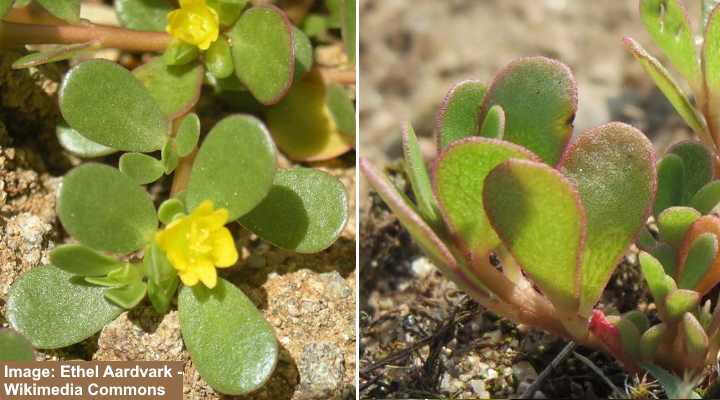
Purslane is a common flowering lawn weed, tough to get rid of. The low-growing outwardly spreading plant quickly becomes invasive if left unchecked. This creeping weed is identified by its small succulent leaves that grow on sprawling red stems and five-petaled yellow flowers. Its aggressive creeping capabilities are from its 50,000 seeds dispersed in a single season.
Purslane is tough to eradicate because its leaves and stems are resilient. Left to grow, it forms a dense carpet that smothers grass, impacting the lawn’s health. Also, this uninvited weed is resistant to certain herbicides, making chemical control methods less effective.
Creeping lawn weed control tips: The best way to control purslane in your lawn is to improve turfgrass density, mow regularly, and use good quality lawn fertilizers.
Chickweed (Stellaria media)

Chickweed is a common annual white flowering lawn weed that plagues cool-season lawns. This low-growing weed has small, oval-shaped leaves and produces small white flowers. Chickweed can quickly spread, forming dense mats in lawns. It also impacts lawn health by competing with grass for nutrients and water. This tough lawn weed reduces the vigor and health of established lawns.
Chickweed is a white flowering weed that spreads rapidly in lawns because it distributes thousands of seeds. Additionally, it thrives in shaded areas where lawn grass growth tends to be weaker. Therefore, it quickly takes root in bare patches of lawn before taking over the whole grassy area.
Creeping lawn weed control tips: Although labor intensive, hand-pulling and spot-treating with herbicides are the best control methods.
Quackgrass (Elytrigia repens)
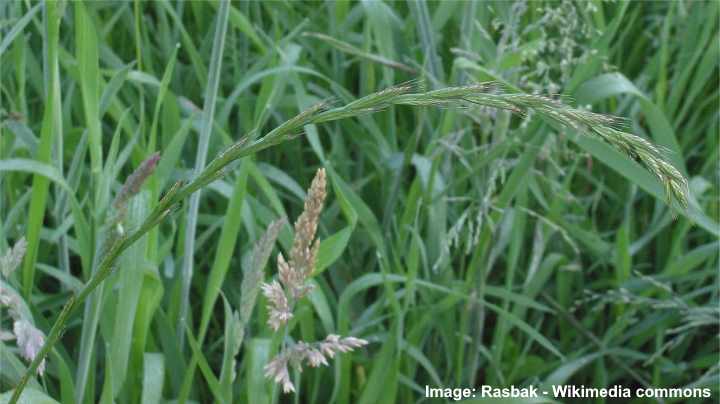
Quackgrass is a perennial grassy weed that can quickly invade lawns and gardens. It spreads through creeping rhizomes and grows rapidly, choking out native grass as it spreads. Quackgrass is identified by its long, narrow leaves with rough edges that form large clumps if left unattended. These quickly spread to form dense patches.
The issues with quackgrass weeds in lawns are their aggressive growth habit and interconnected root system. These features allow it to survive mowing and make other control measures challenging.
Creeping lawn weed control tips: Controlling quackgrass requires constant vigilance to prevent it from regrowing. Growing grass 2.5” to 3” (6 – 7.5 cm) tall can help weaken the weed. Also, pulling the weed by hand and removing its roots can help eradicate it from lawns.
Creeping Thistle (Cirsium arvense)

Creeping thistle is a perennial weed with spiny gray-green leaves that quickly spreads and takes over lawns and gardens. The creeping thistle is identified by its tall, spiky stems and purple flowers that bloom in the summer. Also called Canadian thistle, the noxious weedy plant is challenging to control due to its deep and extensive root system.
Creeping Canada thistle has deeply lobed leaves with spiky edges that detract from a well-maintained lawn. Although mowing can help reduce its aesthetic impact, it’s difficult to eradicate the root.
Creeping lawn weed control tips: Controlling creeping thistle requires digging up the entire root and maintaining healthy, dense turfgrass.
White Clover (Trifolium repens)
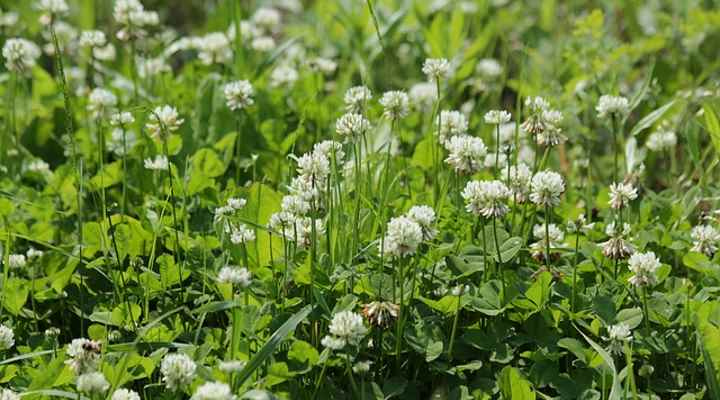
White clover is a creeping lawn weed known for its small, white flowers and three-leaf clover shape. This low-growing perennial weed spreads quickly, thanks to its creeping stems that take root in grass. Its flowerheads consist of up to 80 florets, growing in clusters 1” (2.5 cm) in diameter.
Although it has pretty white flowers, white clover is considered a lawn weed because it can take over lawns and compete with grass for nutrients and space. The low-growing herbaceous weedy plant has some redeeming features—it attracts pollinators and can help prevent soil erosion. It’s also useful for white-flowering ground cover where other plants won’t grow.
Creeping lawn weed control tips: The best way to prevent white clover from taking over lawns is to ensure your lawn is healthy. Also, it’s best not to mow turfgrass too short because white clover weeds thrive in shorter grass.
Japanese Knotweed (Reynoutria japonica)
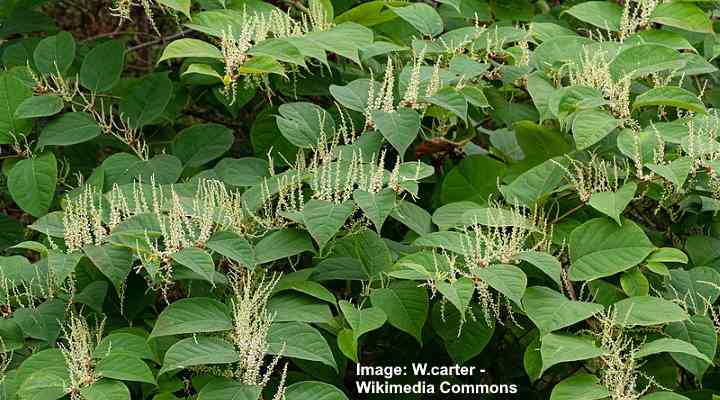
Japanese knotweed is a rapidly spreading, clump-forming weed that spreads through rhizomes deep in the ground. It has large heart-shaped leaves and slender creamy white erect flower spikes that appear in late summer and early fall. Although the weed dies back every year, it grows fast and can reach up to 7 ft. (2.1 m) tall of dense growth.
The new leaves of Japanese knotweed emerge dark red on reddish-purple shoots and can grow up to 5.5” (14 cm) long. The creamy-white flowering spikes grow 6” (15 cm) tall. Although it has an ornamental look, its rapid growth made it unsuitable for planting close to lawns, while its invasive roots can damage pipes, footpaths and even house foundations.
Creeping lawn weed control tips: It’s best to dig out by hand Japanese knotweed when the clumps are small. Make sure to take out all the roots as the weed can regenerate from small pieces of root that remain in the ground. Large clumps might be completely eradicated with herbicides.
Bindweed (Convolvulus arvensis)
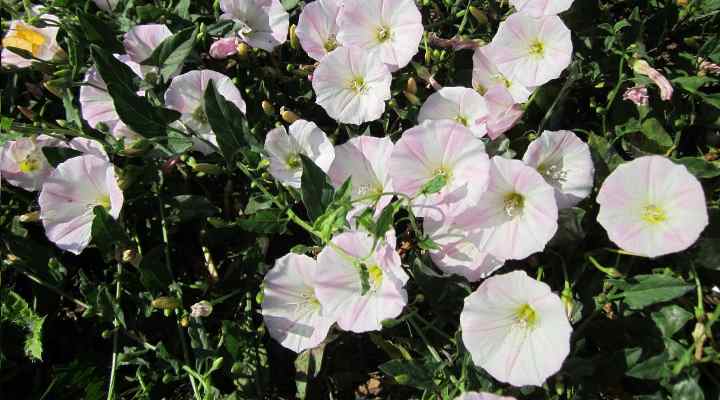
Bindweed is one of the most common lawn weeds in North America. This persistent and invasive creeping plant has vine-like stems that take over poorly maintained lawns. The weed spreads rapidly by fixing its stems to bare patches of soil and is difficult to eradicate.
Despite being a tough lawn weed to get rid of, bindweed is a good ground-hugging plant with pink or white flowers for ground cover. However, it would be best not to plant bindweed near lawns to avoid it taking over your yard.
It is important to note that bindweed can be persistent and may require ongoing efforts to keep it under control. Regular monitoring and maintenance are key to preventing it from spreading and taking over the lawn.
Creeping Buttercup (Ranunculus repens)
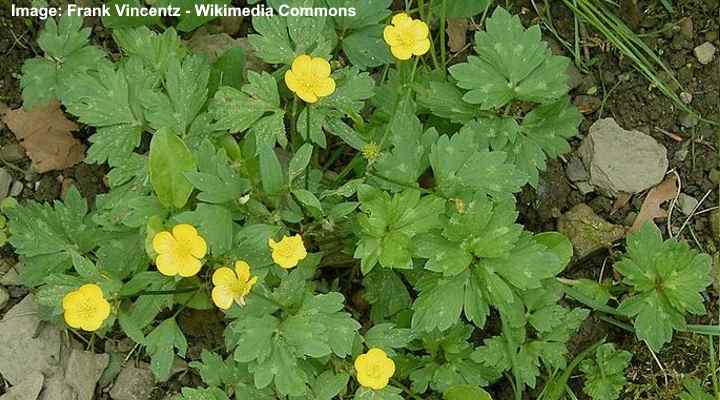
Creeping buttercup is a common weed that invades poorly drained or shaded lawns. Like many invasive creeping plants, the yellow-flowering weed spreads quickly with its above-ground runners and underground rhizomes. This invasive weed has pretty five-petalled yellow flowers growing on erect stems.
Creeping buttercup’s invasive and aggressive growth makes it troublesome in lawns. It competes with grass for resources like nutrients, sunlight, and moisture. And although it has pretty yellow flowers, not everyone wants their lush green lawn dotted with small flowers.
Like controlling most creeping lawn plants, regular mowing, maintaining a healthy lawn, and hand-pulling are the most effective natural treatments.
Prostrate Knotweed (Polygonum aviculare)

Prostrate knotweed is a common low-growing lawn weed that forms dense flattened clumps in compacted soils. This weed is identified by its pinkish-white flowers and spreading stems with small leaves. It is an annual weed that grows at first in semi-erect grass-like stems, but then the weeds spread across the ground and grow in rounded mats.
Prostrate knotweed tends to colonize thin or bare patches of lawns. Like other lawn weeds, it starves grass of essential nutrients, eventually taking over the entire lawn if left unchecked. Even with herbicides, prostrate knotweed is difficult to control; therefore, hand removal seems the most effective way to eradicate it.
Overseeding is an effective way to deal with prostrate knotweed. This lawn-care process helps thicken turfgrass and crowds out prostrate knotweed.
Dallisgrass (Paspalum dilatatum)
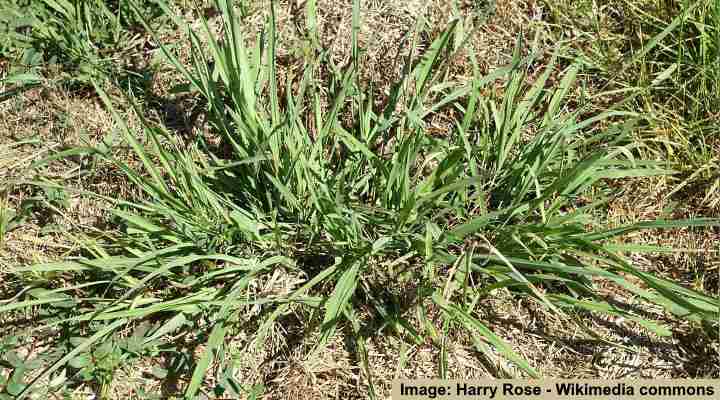
Dallisgrass has short, creeping underground roots that cause the fast-growing lawn weed to spread quickly. This tough lawn weed is identified by stiff tufts in lawns that spread outward. The effect on the appearance of a lawn is that dallisgrass makes the grassy area look bumpy and unsightly.
The invasive nature of dallisgrass weakens the overall health of the lawn. Its thick fibrous roots prevent grass-like blades from getting the required nutrients. Also, the tufts of weedy grass grow significantly longer than regular grass, giving the lawn an unkempt look. This growth feature can make mowing lawns more difficult.
Nimblewill (Muhlenbergia schreberi)
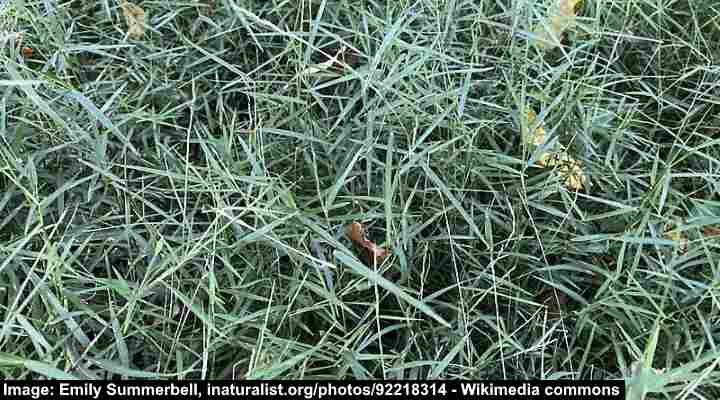
Nimblewill is a warm-season perennial lawn weed that thrives in sunny or shaded areas. Due to its invasive nature, the weed can take over existing lawns. It’s identified by its thin, wiry stems growing 2” (5 cm) long. Its weedy growth forms dense patches or clumps in lawns, creating a patchy appearance.
Interestingly, nimblewill is used as a turfgrass alternative in some southern states in areas where regular warm-season grasses have difficulty growing.
The best way to control nimblewill is to keep your lawn healthy by providing proper irrigation, fertilization, and aeration. Additionally, overseeding your lawn can help encourage grass to choke out invasive nimblewill weeds.
Wild Violet (Viola sororia)
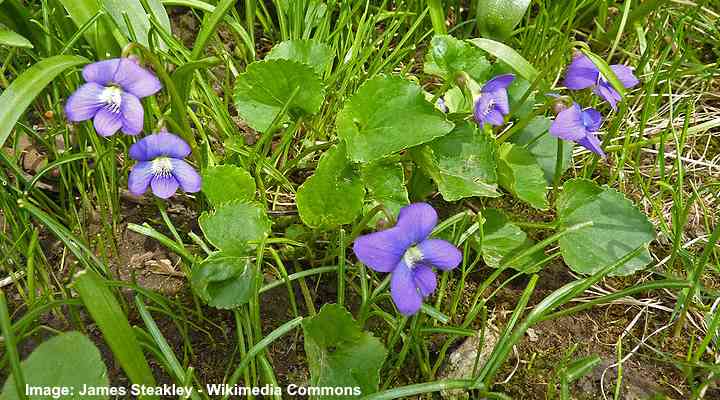
Wild violet is a perennial lawn weed with purple flowers and aggressive growth in full sun or shade. This purple-flowering weed has thick, branching rhizomes that grow uncontrollably. This weed is identified by its heart-shaped leaves and purple or whitish flowers that bloom in the spring. Once established, wild violets are difficult to eliminate.
This low-growing lawn weed spoils lush lawns due to its purple flowers and mat of foliage. Also, the creeping weed thrives in shaded areas where traditional lawn grass may struggle to grow. Wild violet will invade healthy grass once it takes root in poor soil.
Maintaining a healthy lawn with proper mowing techniques, fertilization, and watering is the best way to control wild violet weeds after you have removed them by hand.
Related articles:
